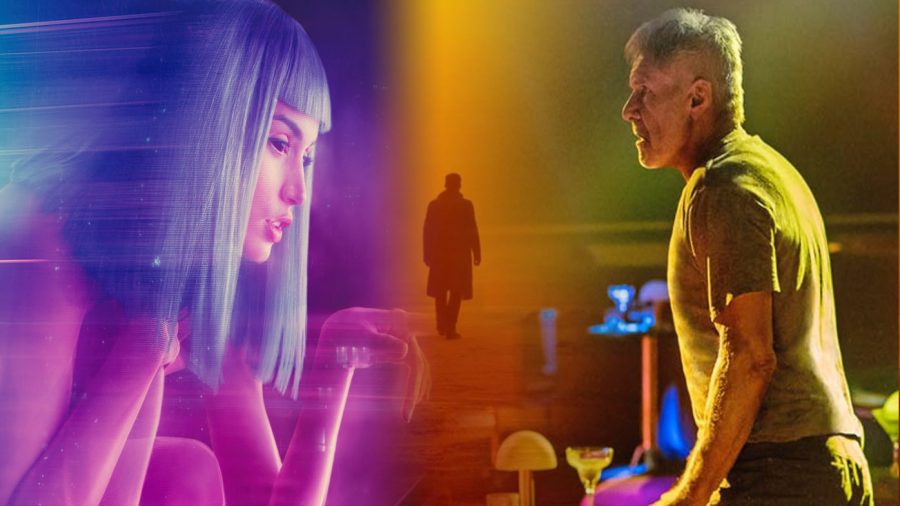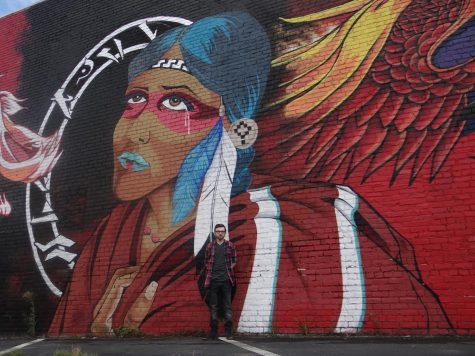DO ANDROIDS DREAM OF ELECTRIC SHEEP?
I. Shank
October 17, 2017
“Blade Runner 2049” is a sequel to Ridley Scott’s cult classic “Blade Runner,” which was released back in 1982. This film is about a blade runner named K who, after completing an assignment, stumbles upon a buried box and a tree with the numbers 6-10-21 inscribed at the bottom of it. Inside the box are remains of the dead body. He finds out that the remains belong to a “replicant” that at one point in time had been pregnant. This sends K on an investigation that eventually becomes a rabbit hole that never seems to end.
“Blade Runner 2049” is a near-flawless film that is easily one of the best, if not the best, movie to ever grace the silver screen. The film raises thought-provoking questions that, for some, may venture into inherently spiritual territory, such as “what makes us human?”; “what does it mean to have a soul?”; “why are humans so special?”; and “does one’s perspective on something change after witnessing a miracle?” The film clocks in at two hours and forty-three minutes (I thought it needed to be longer) but is nonetheless riveting. The film moves as fast as a freight train and doesn’t hold up at any point in the film. Every scene has a purpose whether it be a scene of K talking to his holographic girlfriend, Joi, Jared Leto giving a monologue about creation that seems more poetic than explanatory, or a simple (if not visceral) fight scene. The fight scenes are also something to behold. There’s no shaky cam or dozens of quick cuts. You can see every punch and kick. The sheer magnitude of it all is heightened by the sound mixing. With every punch or kick, you can hear the bones cracking. In the opening scene, K is repeatedly thrown against a wall until he flies through. The audience can hear the wood bending and the flesh pounding against the wall. Some might think those simple details might not mean anything, but once you hear it you can definitely recognize a difference.
As I mentioned before, the original was directed by Ridley Scott (the director behind “Alien” and “Gladiator”). He has since been replaced by Denis Villenueve (the director of “Prisoners” and “Sicario”). That man is most certainly a film auteur. He’s proven time and time again that he is the next great film director. Rarely do we see someone who can become the next Martin Scorsese or Quentin Tarantino. Yet, many have watched his career flourish from his breakthrough film “Incendies” to last year’s Oscar-nominated film “Arrival.” “Blade Runner 2049” cements Denis Villenueve’s place in film history. The man knows how to put characters in contrasting locales and situations and then tell how the two clash against one another. Take, for example, the opening scene. K goes out to “retire” a rogue replicant named Sapper (played by Dave Bautista). Having lived in the neon-tinted city of Los Angeles, he is weary of a desolate landscape that is inhabited by Sapper alone. Then a conversation strikes up between the two. Sapper wants to live, but K needs Sapper dead. A brawl between the two starts shortly thereafter, leaving one of them dead. Through this scene, Denis is able to document what two men, who are intent of living, will do to stay alive. You can really tell here that Denis is fan of the original. You can see the craftsmanship and respect given towards the film. He said in an interview that he and Ryan Gosling came to peace with the fact that the film might be not be welcomed by fans, but they had to be ok with that. I believe that that interaction between the two helped Denis come to terms with his role and make the movie he wanted to tell while still respecting its predecessor. If you weren’t already on board the Villenueve train (I’ve been on it since “Sicario”), you most certainly will be after this.
Ryan Gosling stars as K the film’s protagonist. His performance is very reminiscent of his role in Nicolas Winding Refn’s film “Drive.” He’s a bit of loner that only really seems to care about two things: his job and a girl (in this case it’s a hologram). But what he’s able to achieve here is on a whole different level. In this film, he is able to become one with the character and is able to pull the emotion out of the character in a non-dramatic way. At one instance in the movie, K makes a revelation about himself and instead of giving a typical over-dramatic performance where he’s flipping over tables, he instead has tears rolling down his face and yells in anger and frustration. It’s almost as if he himself had been hurt emotionally and just happened to be standing in front of the camera at the right time. Like I mentioned before, his role as K is very reminiscent of his role from “Drive,” and the fighting styles are almost near identical which is astoundingly phenomenal. Whenever violence erupts, you can see the rage behind his eyes and the anger flowing through his body with his fists trembling after going to work on a person. His acting in the film is much like that of Jack Nicholson in Roman Polanski’s “Chinatown.” He adopts a lot of the traits found in noir characters like Jack Nicholson’s Jake Gitties. He’s very subdued and somber. He gives a lot of his acting through his facial expressions much like Tom Hardy. In the majority of the movie, Gosling wanders around landscapes, reads intel, or is in a fistfight, so he doesn’t get that much to say. You can see the curiosity in his face when he finds a flower in a barren wasteland or when he scours the remains of what once was Las Vegas. His performance is rather mesmerizing.
Harrison Ford reprises his role as Rick Deckard from “Blade Runner” in this film but to avoid spoiler territory I’m not going to reveal how he is relevant to the plot. He’s not in the film for a long time, so don’t be expecting a film where Ford and Gosling are partners the whole time. In fact, it takes a while to get to Deckard, which I appreciated because then it doesn’t feel like the producers crammed him in first thing, just for the sake of fan service. All this being said, his performance shouldn’t be overlooked. This has to be some of Ford’s best work since probably “The Fugitive.” Ford comfortably fits in the shoes of Deckard once again. This time around though, Deckard is an aging man that has been in hiding for years, and Ford did a phenomenal job as an aging Deckard. He’s worn down, calm, and just slightly paranoid.
Jared Leto. Coming off the heels of last year’s “Suicide Squad,” many were worried about his performance for this film. My verdict is that he’s serviceable. He’s not horrendous; it’s just that he isn’t given enough screen time or a particular scene for him to shine in. He plays a man by the name of Niander Wallace who bought the Tyrell Corp and now makes replicants of the “Wallace” brand. His work here is reminiscent of Hannibal Lecter from “The Silence of The Lambs.” Instead of creating havoc, he instead has sequences of exposition to help further the plot.
The real star of the film is Roger Deakins’ cinematography. He was able to get wastelands to look majestic and awe-inspiring. From the neon-lit streets of Los Angeles to the vibrant orange ruins of Las Vegas, each and every shot deserves an Oscar. For example, one shot is of a room with a floor surrounded by water. Yet Deakins was able to frame it just the right way to where when the light hits the water, he was able to capture the water glimmering onto all the walls including the ceiling. And of course I have to mention the shot where Ryan Gosling is bleeding out, and he’s engulfed in the color purple. It’s visually striking and overwhelmingly powerful. He’s been nominated for an Oscar a whopping 13 times. If he doesn’t win this year for his work on “Blade Runner 2049”. . . we riot.
Hans Zimmer score is outstanding as it normally is. Here his score ranges from soft and harmonic to the powerful and bombastic. I still think the soundtrack for “Inception” was his best work, but this is easily a close second. I would definitely recommend seeing this in IMAX 2D like I did. The IMAX enhances the score so much. Having your seat shaken by a Hans Zimmer score is almost a life-altering experience.
I can’t help but praise this film. It has easily topped the likes of “It Comes At Night” and even “Silence” as the best film of the year and has cemented its place as one of my favorite films of all time. On a side note, I do recommend watching the short films that are YouTube. They help explain a few references made in the movie, particularly the anime-short “Blade Runner 2022.”

